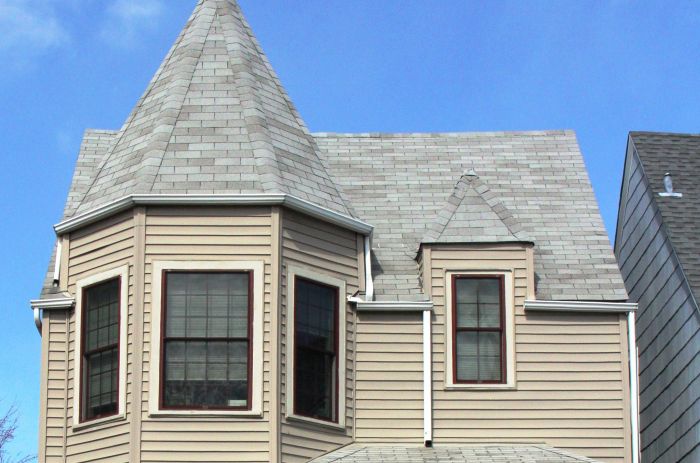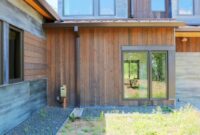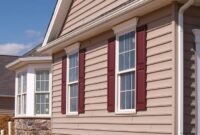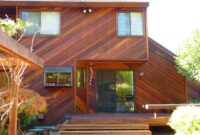Mainstreet siding, the often-overlooked exterior element, significantly impacts a home’s curb appeal and longevity. This comprehensive guide delves into the diverse world of Mainstreet siding, exploring various materials, installation techniques, maintenance strategies, aesthetic considerations, and environmental impacts. From choosing the right siding type to understanding the intricacies of installation and long-term care, we’ll equip you with the knowledge to make informed decisions for your Mainstreet property.
We’ll cover everything from the practical aspects of cost estimation and material selection to the more nuanced considerations of design and sustainability. Whether you’re a homeowner embarking on a renovation project or a professional seeking to enhance your expertise, this guide offers a wealth of information to help you navigate the complexities of Mainstreet siding.
Types of Mainstreet Siding

Choosing the right siding for your home is a crucial decision impacting both aesthetics and longevity. Mainstreet Siding offers a variety of materials, each with its own set of advantages and disadvantages. Understanding these differences is key to making an informed choice that best suits your needs and budget. This section details the properties of several common Mainstreet siding options.
Vinyl Siding
Vinyl siding is a popular choice due to its affordability and low maintenance. It’s manufactured from polyvinyl chloride (PVC), a durable plastic known for its resistance to moisture and rot. This makes it an excellent choice for climates with high humidity or frequent rainfall. However, vinyl siding can be susceptible to damage from extreme temperatures, potentially leading to warping or cracking in very hot or cold conditions. Its relatively low cost often translates to a shorter lifespan compared to other materials. Additionally, vinyl siding’s aesthetic appeal might be considered less sophisticated than some alternatives. It’s also important to note that vinyl siding is not as environmentally friendly as some other options.
Fiber Cement Siding
Fiber cement siding combines cement, cellulose fibers, and other additives to create a durable and long-lasting exterior cladding. It offers superior resistance to fire, insects, and rot, making it a highly desirable option for homeowners seeking a low-maintenance, high-performance solution. While more expensive than vinyl, fiber cement siding provides exceptional longevity, often lasting for decades with minimal upkeep. Its realistic wood-grain textures and varied color options allow for a wide range of aesthetic choices. However, fiber cement siding is heavier than vinyl, requiring more robust installation techniques and potentially higher labor costs. It can also be more prone to cracking if not installed correctly.
Wood Siding
Wood siding offers a classic, natural aesthetic that’s highly sought after. It’s available in various species, each with unique grain patterns and colors. Wood siding can be stained or painted to match any style. However, wood requires significant maintenance to prevent rot, insect infestation, and weathering. Regular painting or staining is necessary, along with occasional repairs. Compared to vinyl or fiber cement, wood siding has a shorter lifespan unless properly maintained, and it’s susceptible to moisture damage. The cost can also vary greatly depending on the wood species and quality.
Metal Siding
Metal siding, often made from aluminum or steel, is exceptionally durable and long-lasting. It’s resistant to fire, insects, and rot, requiring minimal maintenance. Metal siding is also highly energy-efficient, reflecting sunlight and reducing cooling costs. Its strength and resistance to damage make it a popular choice in areas prone to extreme weather conditions. However, metal siding can be more expensive than vinyl or wood and may dent or scratch more easily than fiber cement. The aesthetic appeal of metal siding can vary; some find it modern and sleek, while others may consider it less visually appealing than other options. The potential for noise from rain or hail impacting the metal surface is also a consideration.
Comparison of Mainstreet Siding Options
| Siding Type | Cost (Relative) | Maintenance | Aesthetic Appeal |
|---|---|---|---|
| Vinyl | Low | Low | Moderate |
| Fiber Cement | Medium-High | Low | High |
| Wood | Medium | High | High |
| Metal | High | Low | Moderate-High |
Mainstreet Siding Installation

Installing Mainstreet siding requires careful planning and execution to ensure a long-lasting, aesthetically pleasing, and weather-resistant exterior. This process involves several key steps, from initial preparation to final fastening, all demanding precision and attention to detail. Proper installation techniques are crucial for maximizing the lifespan and performance of your siding.
Preparation and Measurements
Before beginning installation, thorough preparation is essential. This includes removing existing siding, cleaning the underlying surface, and ensuring the structural integrity of the wall sheathing. Any damaged or deteriorated wood should be repaired or replaced. Accurate measurements of the wall area are critical for determining the quantity of siding needed. This involves accounting for windows, doors, and other architectural features. Precise measurements prevent material waste and ensure a seamless finish. A detailed plan, including a diagram showing the siding layout, is highly recommended. This plan should account for starting points, overlap, and the placement of any trim pieces.
Siding Installation Techniques
Mainstreet siding installation typically begins at a corner or a predetermined starting point. The first panel is installed, ensuring proper alignment and levelness. Subsequent panels are then attached, overlapping the previous ones according to the manufacturer’s specifications. Fastening is usually done using nails or screws, driven into the sheathing through pre-drilled holes in the siding. It is vital to avoid over-driving fasteners, which can damage the siding and compromise its water resistance. Proper spacing between fasteners is also crucial to allow for expansion and contraction due to temperature fluctuations. Using a nail gun can significantly speed up the installation process while maintaining consistency in fastening.
Ventilation and Water Management
Proper ventilation is crucial to prevent moisture buildup within the wall assembly. This is achieved by ensuring adequate space between the siding and the sheathing, allowing for air circulation. Water management is equally important, and this involves installing flashing around windows and doors to prevent water penetration. Properly sealed seams and joints are also essential to prevent water ingress. Using a water-resistant barrier behind the siding provides an additional layer of protection. Regular inspection of the siding after installation is recommended to identify and address any potential issues promptly. For example, proper flashing installation prevents water from seeping behind the siding around window frames, a common cause of damage if not addressed correctly.
Tools and Equipment, Mainstreet siding
A successful Mainstreet siding installation requires the right tools. Essential equipment includes measuring tapes, levels, chalk lines, drills, nail guns or hammers, saws (circular saw or hand saw), safety glasses, and work gloves. Other useful tools include a utility knife, a caulking gun, and a ladder. Depending on the complexity of the installation, specialized tools may be needed. For example, a laser level can ensure precise alignment across large areas, improving installation accuracy and reducing potential issues.
Potential Challenges and Solutions
Proper planning can mitigate many potential challenges during Mainstreet siding installation.
- Uneven Wall Surfaces: Uneven surfaces can lead to gaps and inconsistencies in the siding. Solution: Use shims to level the panels before fastening.
- Difficult-to-Reach Areas: Installing siding in hard-to-reach areas, such as around corners or under eaves, can be challenging. Solution: Use extension ladders and specialized tools.
- Weather Conditions: Extreme temperatures or inclement weather can affect installation speed and quality. Solution: Plan the installation during favorable weather conditions.
- Material Damage: Improper handling or storage can lead to damage to the siding. Solution: Handle the siding carefully and store it properly before and during installation.
- Fastener Issues: Incorrect fastener placement or type can compromise the siding’s integrity. Solution: Use the recommended fasteners and follow manufacturer’s guidelines for spacing and placement.
Mainstreet Siding Maintenance and Repair

Proper maintenance is crucial for extending the lifespan and preserving the aesthetic appeal of your Mainstreet siding. Regular cleaning and prompt attention to minor damage can prevent costly repairs down the line and maintain your home’s curb appeal. This section details routine maintenance procedures, repair techniques for various siding materials, and solutions for common problems.
Routine Maintenance Procedures
Regular cleaning is the cornerstone of Mainstreet siding maintenance. Depending on your siding material (vinyl, fiber cement, etc.), the cleaning methods will vary slightly, but the frequency should remain consistent. For instance, vinyl siding generally requires annual cleaning, while fiber cement might benefit from more frequent attention, especially in areas with heavy environmental pollutants. Using a soft-bristled brush and a solution of mild detergent and water is generally sufficient for most cleaning tasks. Power washing should be approached cautiously and only used at a low pressure to avoid damaging the siding. Inspecting the siding for any signs of damage or deterioration during the cleaning process is also highly recommended.
Cleaning and Repairing Minor Damage
The specific cleaning and repair methods depend heavily on the type of Mainstreet siding installed. For vinyl siding, a simple solution of mild detergent and water, applied with a soft brush, usually suffices for cleaning. Minor scratches can often be buffed out with a soft cloth. For more significant damage, such as cracks or holes, replacement of the affected panel may be necessary. Fiber cement siding requires a more careful approach. While it’s more durable than vinyl, aggressive cleaning can damage its surface. A soft brush and a solution of water and a mild cleaner are recommended. Minor chips or cracks can sometimes be repaired with a specialized patching compound designed for fiber cement, followed by painting to match the existing color. Always refer to the manufacturer’s instructions for specific cleaning and repair guidelines for your siding type.
Common Problems and Solutions
Several issues can affect Mainstreet siding over time. One common problem is caulking failure around windows and doors, leading to water intrusion. Regular inspection and prompt recaulking are essential to prevent water damage. Another common problem is the accumulation of mildew or algae, particularly in shaded or humid areas. A solution of bleach and water (following the manufacturer’s dilution instructions) can effectively remove these growths. However, always test the solution in an inconspicuous area first to ensure it doesn’t damage the siding. Finally, loose or damaged siding panels are a serious concern. These should be repaired or replaced immediately to prevent further damage and maintain the structural integrity of your home’s exterior. Ignoring these issues can lead to significant and costly repairs in the future.
Troubleshooting Mainstreet Siding Issues
The following flowchart illustrates a systematic approach to troubleshooting common Mainstreet siding problems:
| Problem | Possible Cause | Solution |
|---|---|---|
| Water intrusion | Cracked caulking, damaged siding | Recaulk, replace damaged siding |
| Mildew/Algae growth | Moisture, shade | Clean with bleach solution |
| Loose or damaged siding | Impact damage, age, improper installation | Repair or replace siding panels |
| Discoloration | Sun exposure, pollutants | Clean siding, consider repainting (for certain materials) |
Aesthetic Considerations for Mainstreet Siding
Choosing the right siding for a Mainstreet building significantly impacts its curb appeal and overall aesthetic. The interplay of color, style, texture, and pattern can transform a house from ordinary to extraordinary, reflecting the homeowner’s personal style and enhancing the neighborhood’s character. Careful consideration of these aesthetic elements ensures a visually harmonious and lasting impression.
Impact of Color and Style on Mainstreet Building Aesthetics
Mainstreet siding offers a wide array of colors and styles, each capable of dramatically altering the perceived size, shape, and character of a home. Darker colors, such as deep blues or charcoal grays, can create a sense of sophistication and formality, while lighter colors, like creamy whites or soft pastels, evoke feelings of warmth and airiness. The style of the siding itself—be it clapboard, shingle, or board-and-batten—further contributes to the overall aesthetic. For instance, traditional clapboard siding lends itself to classic, colonial-style homes, while more modern styles, such as horizontal shiplap, are better suited to contemporary designs. The choice of color and style should always be considered in relation to the existing architectural features and the surrounding landscape.
Mainstreet Siding Complementing Various Architectural Styles
Mainstreet siding’s versatility allows it to complement a wide range of architectural styles. For a Victorian-era home, detailed shingle siding in muted earth tones, accented with contrasting trim, can enhance its ornate details. A Craftsman-style home might benefit from wider board-and-batten siding in natural wood tones or deep browns, emphasizing its horizontal lines and handcrafted feel. For a more modern farmhouse, clean lines and a simple color palette—perhaps a muted gray or white—would be suitable. The key is to select siding that harmonizes with the existing architectural elements and enhances the home’s unique character.
Examples of Mainstreet Homes with Varied Siding Choices
Home 1: Classic Colonial
This home features traditional white clapboard siding with black shutters and a crisp white trim. The color palette is simple yet elegant, creating a timeless aesthetic. The symmetrical design is further emphasized by the evenly spaced clapboards and the symmetrical placement of the windows. The overall impression is one of refined elegance and classic charm.
Home 2: Modern Farmhouse
This home showcases horizontal shiplap siding in a warm gray tone, complemented by dark gray trim and black accents around the windows and doors. The texture of the shiplap adds visual interest, while the neutral color palette maintains a clean, modern look. The overall effect is a stylish and inviting home that blends rustic charm with contemporary simplicity.
Home 3: Craftsman Bungalow
This home utilizes wider board-and-batten siding in a rich, dark brown hue. The natural wood tones create a warm and inviting atmosphere. The prominent horizontal lines of the siding emphasize the low-pitched roof and wide eaves, characteristic of Craftsman architecture. Subtle variations in wood tones add depth and visual interest without detracting from the overall cohesiveness of the design. The trim is a slightly lighter shade of brown, offering a delicate contrast.
Comparison of Siding Textures and Patterns in Mainstreet Settings
The texture and pattern of Mainstreet siding play a significant role in the overall aesthetic. Smooth siding creates a clean, modern look, while textured siding, such as cedar shakes or stone-look vinyl, adds visual interest and depth. Vertical siding patterns tend to make a home appear taller and narrower, while horizontal patterns create a wider, more sprawling appearance. The choice between smooth and textured siding, as well as the direction of the pattern, should be carefully considered in relation to the home’s size, shape, and architectural style. For example, textured siding can help to break up the monotony of a large, plain facade, while vertical siding can visually elongate a low-slung ranch-style home.
Environmental Impact of Mainstreet Siding
Choosing siding for your home involves more than just aesthetics and cost; it also carries significant environmental implications. The manufacturing process, material lifespan, and eventual disposal methods of your siding all contribute to its overall environmental footprint. Understanding these factors is crucial for making an informed and sustainable choice. This section examines the environmental impact of various Mainstreet siding materials, highlighting sustainable options and providing a comparison of their recyclability and carbon footprint.
Manufacturing Processes and Material Lifespan
The environmental impact of Mainstreet siding begins with its manufacturing. Energy-intensive processes, the use of raw materials, and associated emissions vary significantly depending on the material. For instance, vinyl siding, while often inexpensive, requires substantial energy for its production and relies heavily on fossil fuels. Its longevity, while generally long, doesn’t fully offset this initial environmental burden. Conversely, materials like fiber cement often have a higher upfront energy cost but boast a significantly longer lifespan, potentially reducing the overall environmental impact over time. Wood siding, depending on its source and treatment, presents a varied environmental profile. Sustainably harvested wood with minimal chemical treatments has a lower impact than wood sourced from unsustainable practices. Metal sidings, such as aluminum or steel, require significant energy for production but are highly durable and potentially recyclable.
Sustainable and Eco-Friendly Siding Options
Several Mainstreet siding options offer more sustainable alternatives. Recycled materials are a key component of environmentally conscious siding choices. Some manufacturers incorporate recycled content into their vinyl or composite products, reducing the demand for virgin materials. Furthermore, choosing sidings made from rapidly renewable resources, such as bamboo or sustainably harvested wood, minimizes deforestation and supports responsible forestry practices. Fiber cement siding, while not inherently “green” in its production, often possesses a long lifespan, reducing the frequency of replacement and the associated waste generation.
Recyclability and Carbon Footprint Comparison
The following table compares the recyclability and estimated carbon footprint of various Mainstreet siding materials. Note that these values are estimates and can vary based on manufacturing processes, transportation distances, and specific product formulations. Accurate data requires detailed Life Cycle Assessments (LCAs) for each specific product.
| Siding Material | Recyclability | Estimated Carbon Footprint (kg CO2e/m²) | Notes |
|---|---|---|---|
| Vinyl | Limited; often landfilled | High (estimated 10-15 kg CO2e/m²) | High energy consumption during manufacturing; limited recycling infrastructure. |
| Fiber Cement | Some components recyclable; often landfilled | Medium (estimated 6-10 kg CO2e/m²) | Higher initial energy consumption but long lifespan. |
| Wood (Sustainably Harvested) | Potentially recyclable (depending on treatment); can be repurposed | Low to Medium (estimated 3-8 kg CO2e/m²) | Carbon sequestration potential; recyclability depends on treatment. |
| Aluminum | Highly recyclable | Medium (estimated 7-12 kg CO2e/m²) | High energy consumption during manufacturing; excellent recyclability. |
| Steel | Highly recyclable | Medium (estimated 8-13 kg CO2e/m²) | High energy consumption during manufacturing; excellent recyclability. |
Cost Analysis of Mainstreet Siding Projects
Estimating the total cost of a Mainstreet siding project requires a comprehensive approach, considering various factors that can significantly impact the final price. Accurate cost estimation is crucial for budgeting and project planning, ensuring a smooth and financially responsible installation process. This analysis will break down the key cost components and provide examples to illustrate potential scenarios.
Material Costs
Mainstreet siding material costs vary considerably depending on the type of siding chosen (e.g., vinyl, fiber cement, wood), its quality, and the size of the project. Vinyl siding is generally the most affordable option, while fiber cement and wood siding command higher prices due to their durability and aesthetic appeal. The cost is typically calculated per square foot, with prices ranging from a few dollars per square foot for basic vinyl to over $10 per square foot for high-end wood siding. For example, a 1,500 square foot home might require $3,000 – $15,000 worth of siding materials alone, depending on the chosen material. Additional materials, such as flashing, trim, and fasteners, should also be factored into the overall cost.
Labor Costs
Labor costs constitute a significant portion of the total project expense. The hourly rate for siding installers varies geographically and depends on their experience and expertise. The total labor cost is determined by the project’s complexity, the size of the house, and the number of installers required. A simple siding installation might cost $3-$5 per square foot for labor, while more complex projects, involving extensive repairs or intricate designs, could cost significantly more. For the same 1,500 square foot home, labor costs could range from $4,500 to $7,500.
Permitting Costs
Building permits are typically required for exterior renovations, including siding installation. The cost of permits varies by location and the scope of the project. Some municipalities charge a flat fee, while others base their fees on the project’s estimated value. It’s advisable to contact your local building department to determine the exact permitting costs for your specific project. Permitting costs are usually a smaller fraction of the total cost, ranging from a few hundred to a thousand dollars.
Cost Scenarios
To illustrate different cost scenarios, consider these examples for a 1,500 square foot home:
| Scenario | Siding Material | Material Cost | Labor Cost | Permitting Cost | Total Estimated Cost |
|---|---|---|---|---|---|
| Budget-Friendly | Vinyl Siding (Basic) | $3,000 | $4,500 | $500 | $8,000 |
| Mid-Range | Fiber Cement Siding | $8,000 | $6,000 | $700 | $14,700 |
| High-End | Wood Siding (Premium) | $15,000 | $7,500 | $1,000 | $23,500 |
Factors Influencing Total Cost
Several factors beyond material and labor can influence the overall cost. These include:
- Existing Siding Condition: Removing old siding adds to labor and disposal costs. Extensive repairs to underlying sheathing or wall structure can significantly increase the overall project expense.
- Project Complexity: Intricate designs, multiple colors, or the need for custom trim work can increase both material and labor costs.
- Accessibility: Difficult-to-reach areas or multi-story homes may require specialized equipment or additional labor, thus increasing the cost.
- Geographic Location: Labor and material costs vary geographically, with higher costs in areas with a higher cost of living.
- Contractor Fees: Different contractors have different pricing structures. Obtaining multiple bids is crucial for comparing prices and finding the best value.
Ultimately, selecting and installing Mainstreet siding is a multifaceted process that demands careful consideration of numerous factors. From the initial material selection, weighing durability against cost and aesthetic preferences, to the meticulous installation process and ongoing maintenance, each step plays a vital role in the long-term success of your project. By understanding the nuances of each stage, you can ensure a beautiful, durable, and environmentally responsible exterior for your Mainstreet home, enhancing its value and curb appeal for years to come. This guide provides a solid foundation for making those informed decisions, transforming your vision into a reality.
Popular Questions
What is the average lifespan of different Mainstreet siding materials?
Lifespans vary greatly. Vinyl siding can last 20-30 years, fiber cement 50+ years, wood 20-50 years (depending on maintenance), and metal 40+ years.
Can I install Mainstreet siding myself?
While possible for some types, professional installation is generally recommended for optimal results and warranty validity. It’s a complex process best left to experienced contractors, especially for larger projects.
How often should I clean my Mainstreet siding?
Regular cleaning (at least once or twice a year) is crucial. Use a soft brush, mild detergent, and water. Pressure washing should be done cautiously to avoid damage.
What are the common signs of Mainstreet siding damage?
Look for cracks, warping, discoloration, loose or missing pieces, and signs of water damage. Address these issues promptly to prevent further deterioration.
Are there any building codes or permits required for Mainstreet siding installation?
Yes, always check with your local building department for necessary permits and compliance with building codes before starting any project.


